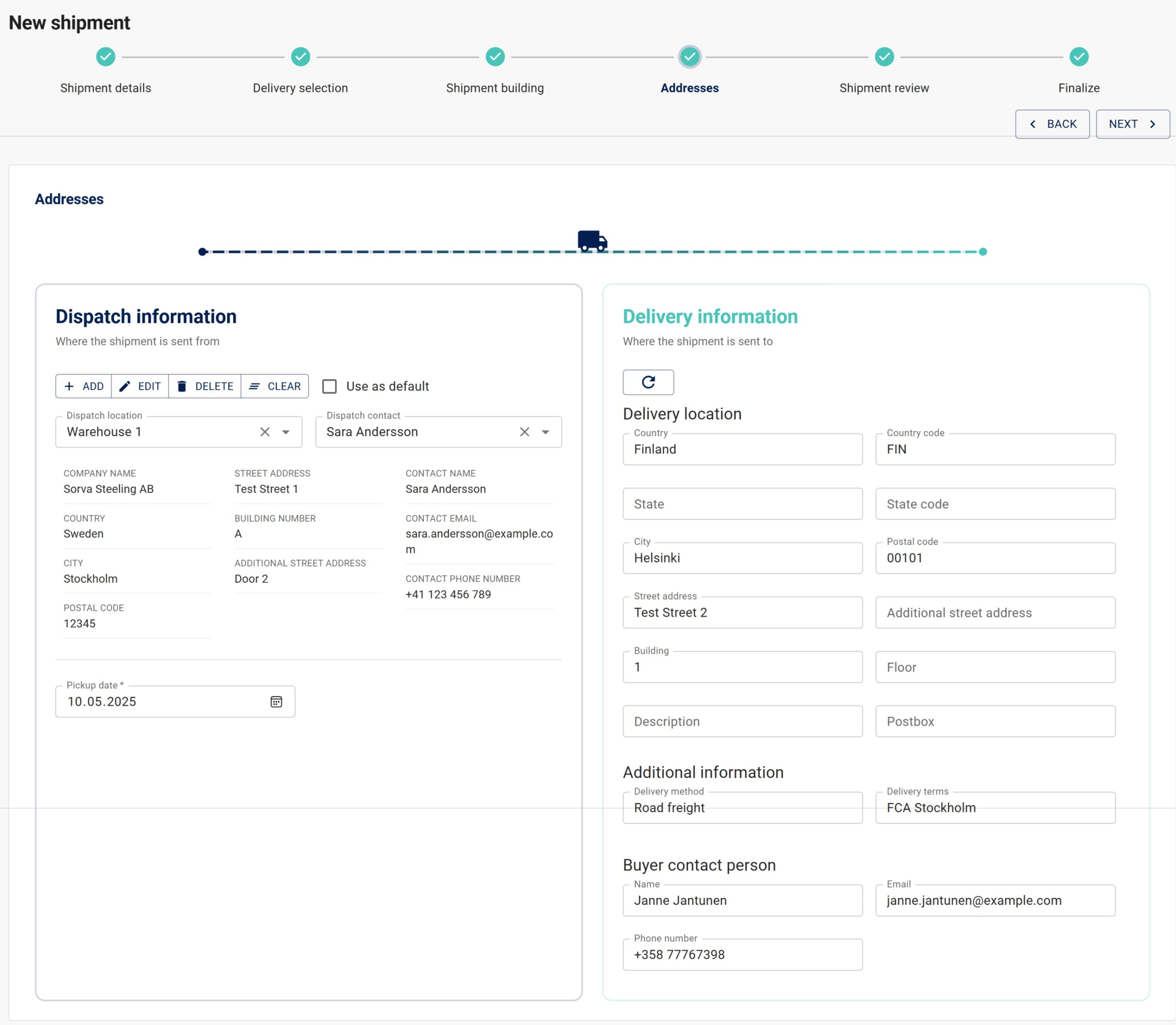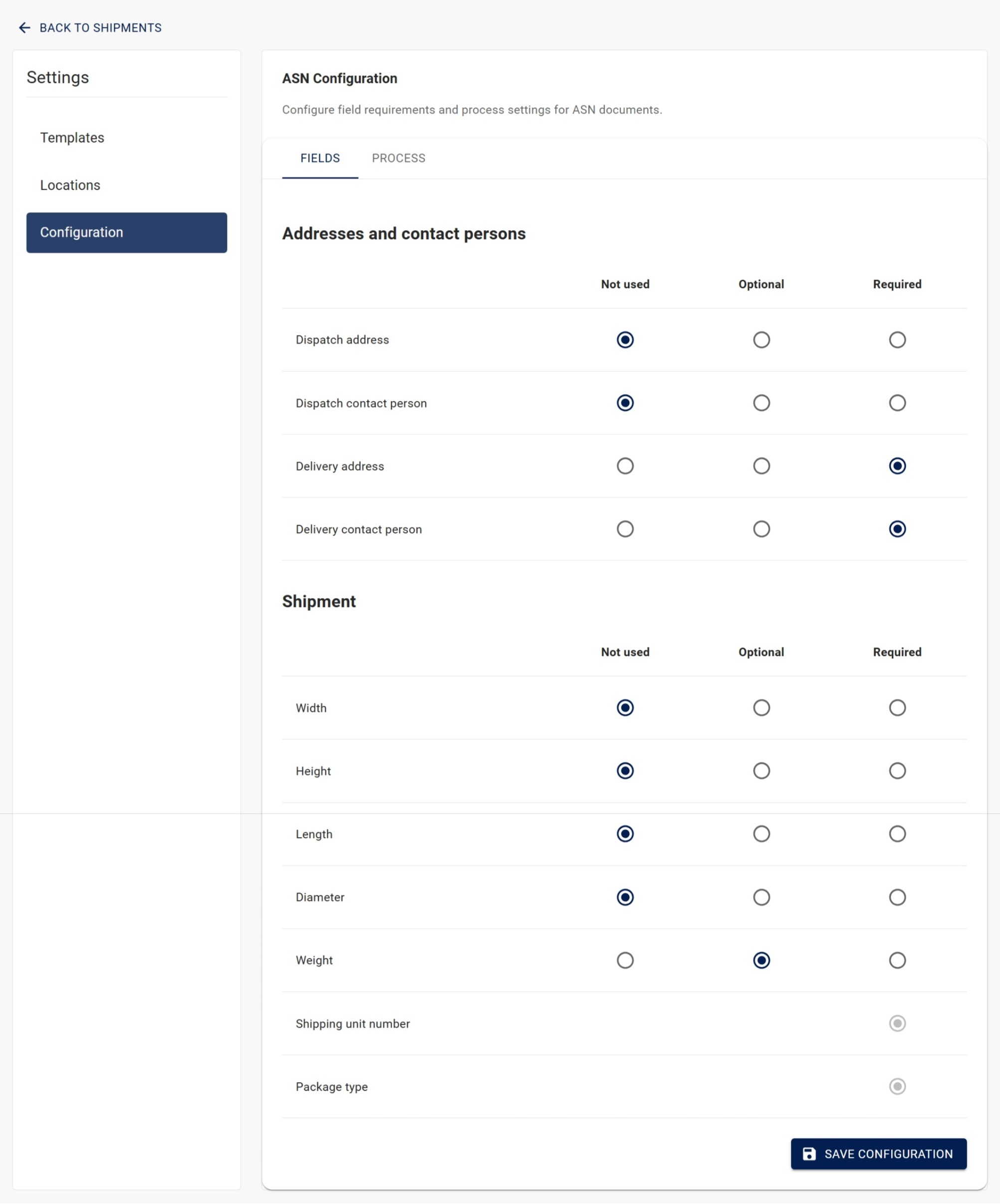Advance Shipping Notice (ASN)
The goal of this update is to improve usability and streamline the creation of ASN messages.
What is improved?
- Easily follow the shipment creation process step by step with a new progress bar
- No more unnecessary data entry – you will only see the fields required by your customer
- Smoother shipment building: drag items easily into shipping units and use the new autopack feature to quickly place products into identical shipment units
Instructions on this page were updated on November 11 to align with the new version.
This document is primarily intended for supplier companies, providing instructions on how to create ASNs in Jakamo.
Jakamo customer companies utilize the ASN feature by configuring it and integrating it with their internal systems, such as ERP, WMS, TMS, or other similar platforms. Customers can find the ASN API description at technical documentation.
1. Short introduction to Jakamo ASN
An ASN is an electronic document that provides detailed information about an upcoming shipment. It is sent by the supplier or carrier to the recipient, typically the customer’s warehouse, to notify them in advance of the delivery.
In Jakamo, the ASN includes essential details such as:
- Shipment contents based on the purchase order
- Item quantities
- Packaging information
- Expected delivery date
- Any special instructions or requirements
Receiving an ASN allows the customer to prepare for the shipment’s arrival, improving coordination and efficiency.
Benefits of using Jakamo ASN
For both suppliers and customers, Jakamo ASN offers:
- Improved visibility to upcoming shipments
- Streamlined logistics processes with real-time data
- Fewer errors with standardized process
- Increased operational efficiency
- Stronger collaboration
🎥 Watch a short tutorial video where Samuli from Jakamo briefly explains what an ASN is and how to easily create one in Jakamo.
2. Jakamo ASN - how to access it?
The ASN (Advance Shipping Notice) feature is available in the Orders application. To enable ASN functionality, the customer company must first activate it in their Jakamo account and configure the supplier in the ASN integration settings. Once this is done, the supplier will also gain access to ASN functionality through their Jakamo account.
If ASN is available for you with your customer, a tab called SHIPMENTS will appear at the top of the Orders application list view page.
Example: ASN is activated and shipment tab is available on the top of the Orders app list view page

3. Shipments
Access the Shipments tab by clicking Shipments on the top of the Orders app list view:
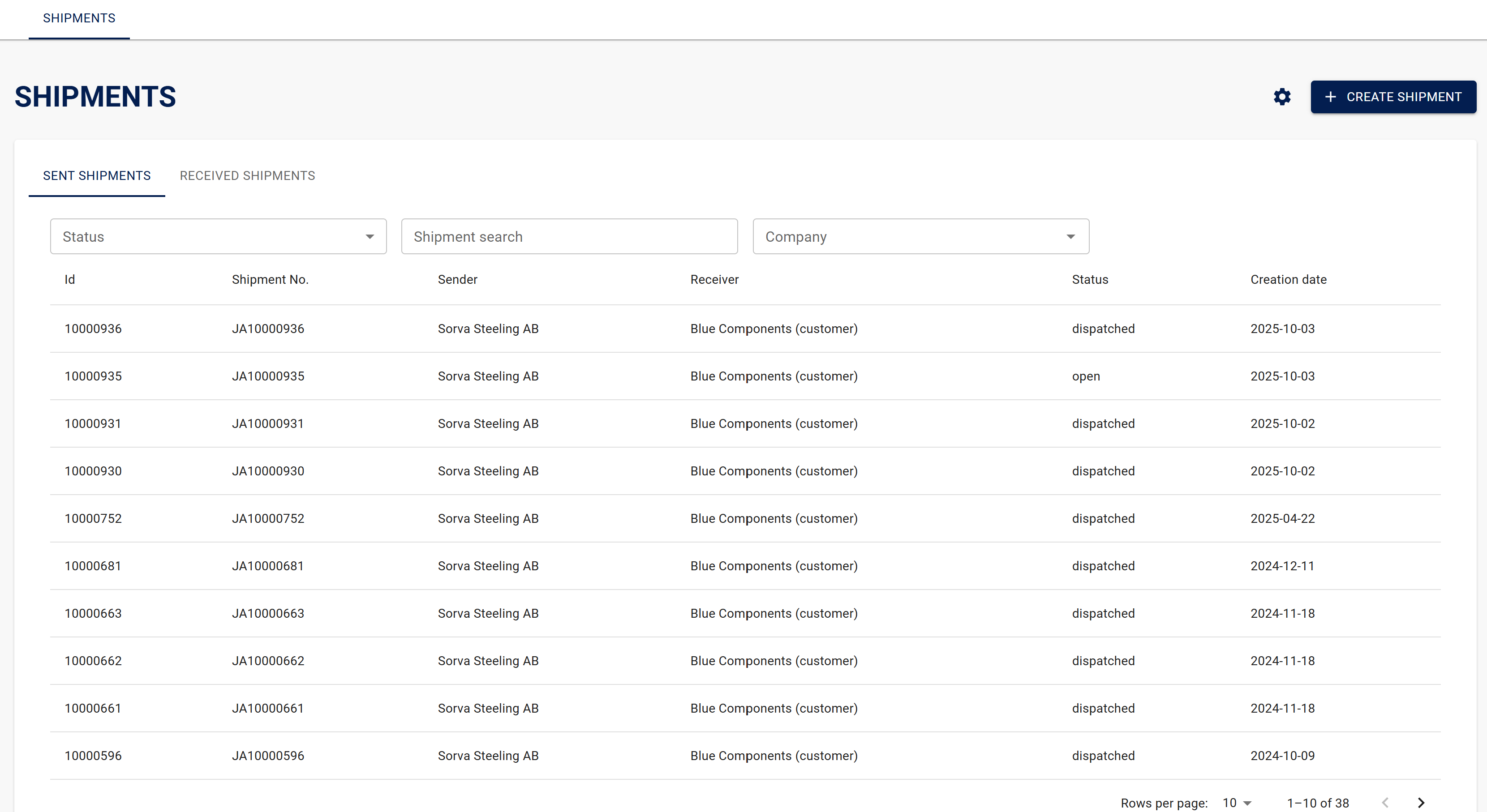
Shipping notice list view displays all sent and received shipments. If you are operating as a supplier, you will most likely find ASNs under the Sent shipments tab. If you are a customer, ASNs are typically listed under the Received shipments tab.
4. Creating a new shipment
Start creating a new shipment by selecting CREATE SHIPMENT:

The ASN creation consists of six stages. Each of them will now be presented step by step. After completing each section, select Next > at the top or bottom of the page.
4.1 Shipment details
Start the shipment creation by filling the basic information of the shipment. All the fields explained shortly:
- Recipient company: Select the customer whose order you are delivering from the dropdown menu. A single shipment may only contain products from one customer's orders.
- Shipment No.: Fill in the shipment number here. It can be a waybill number, bill of lading number, tracking number, or any other number that identifies the shipment. If the customer has set automatic fullfilment of the shipment number, it will be disabled for manual entry.

4.2 Delivery selection
Select deliveries (delivery batches) you are about to deliver with this shipment. Find desired deliveries by searching with PO number, delivery batch number, item name or item number. User may also filter the search by order status (confirmed or not confirmed) or by the shipment status (all, sent, unsent, received).
Example: we are searching for POs, delivery batches, item names or item numbers with number 777 in it. Please note that you may have and therefore select items from multiple POs into a single shipment.

Select desired delivery batches by selecting the tickbox of the delivery. You may search multiple different deliveries from different orders, and your selections will remain.
By default, Jakamo displays confirmed and unshipped orders and delivery batches in the list. To view unconfirmed orders and delivery batches, adjust the search filters by modifying the Order Status and Delivery Status search filters.
4.3 Shipment building
Build your shipment by selecting the types of shipping units it will include. Then, assign each item to the appropriate shipping unit. A shipment can contain one or multiple shipping units, which may be identical or different in type. Shipping units can also be nested within each other, forming a parent-child structure.
4.3.1 Create shipping units manually
Add one new shipping unit to your shipment by selecting + NEW UNIT:
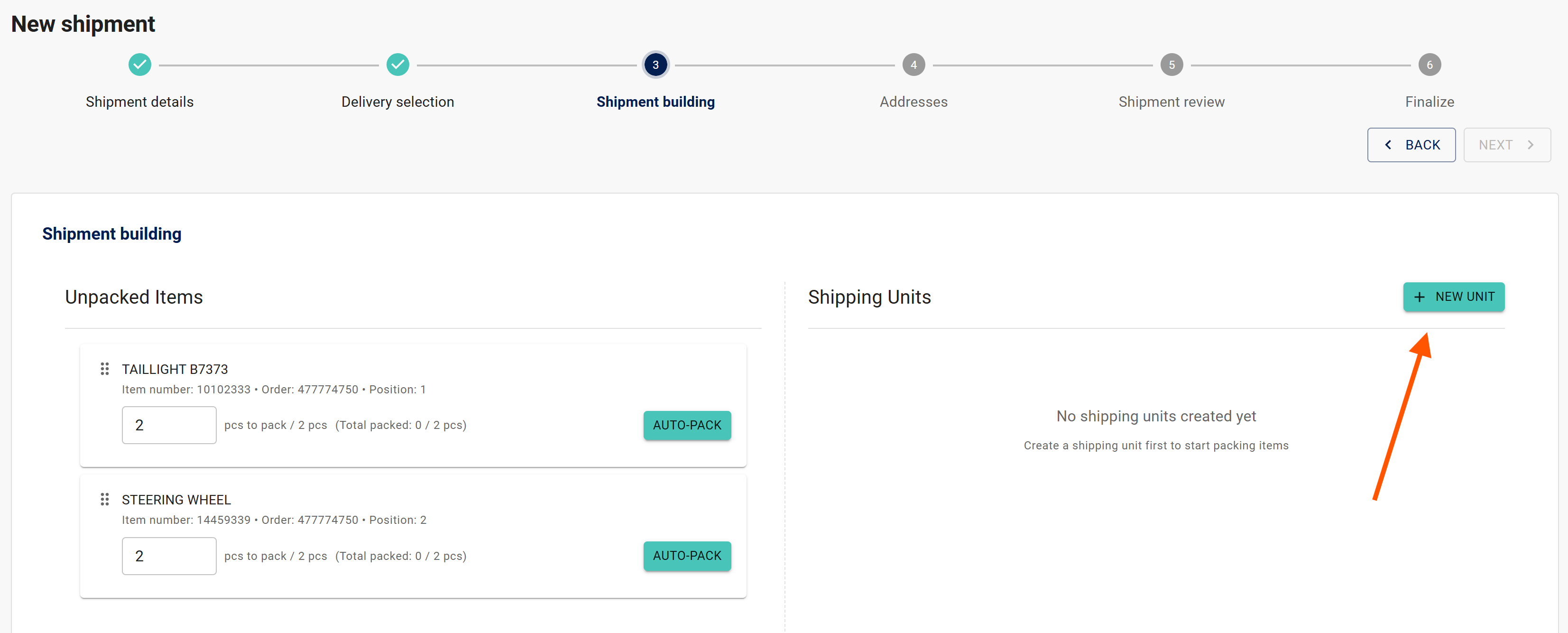
Create new shipping unit:
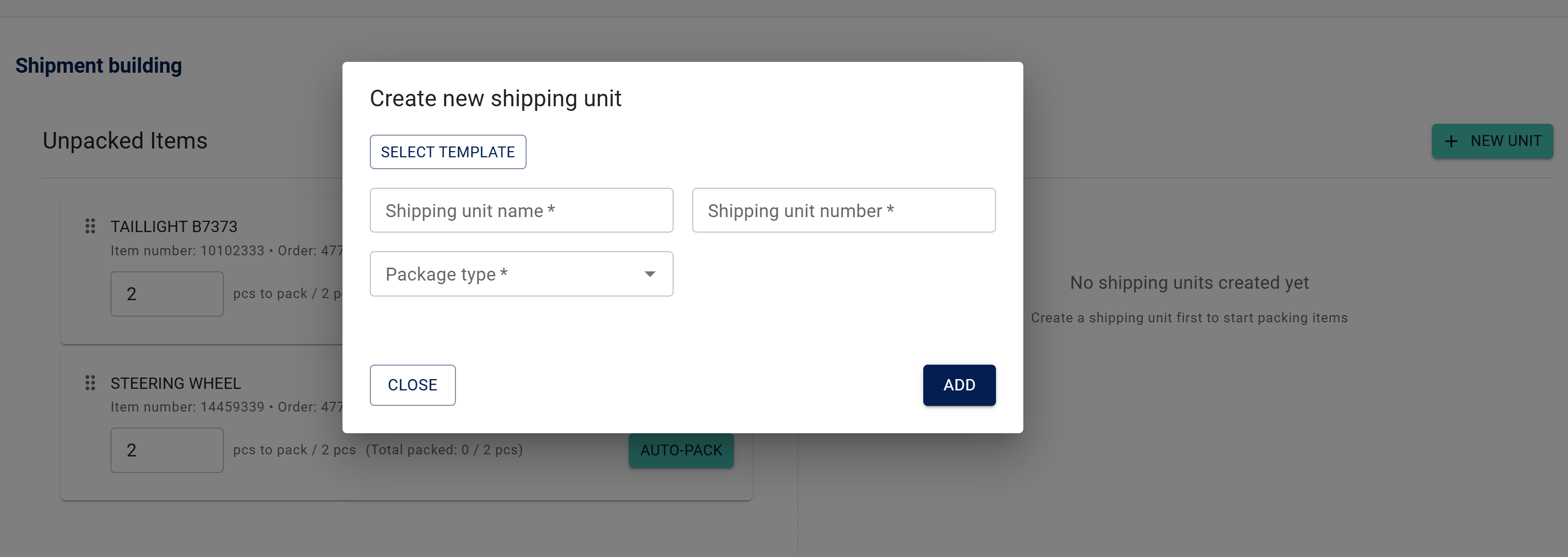
- Select template: Choose from pre-defined shipping units provided by your customer
- Shipping unit name: Assign a unique name to this shipping unit
- Shipping unit number: Assign a unique identifier to this shipping unit
- Package type: Select a package type from the pre-defined options
If the customer requires dimensions or other measures for the shipping unit, dedicated fields for various measurements will also be shown when creating the shipping unit (e.g. width, height, weight).
Select ADD to create a new shipping unit for the shipment.
4.3.2 Create multiple shipping units with autopack
Auto-pack helps you quickly pack your items into shipping units without having to create each unit manually. Use the auto-pack functionality when you need to create multiple identical shipment units that contain the same number of items.
Select AUTO-PACK to start auto-packing process for selected items.
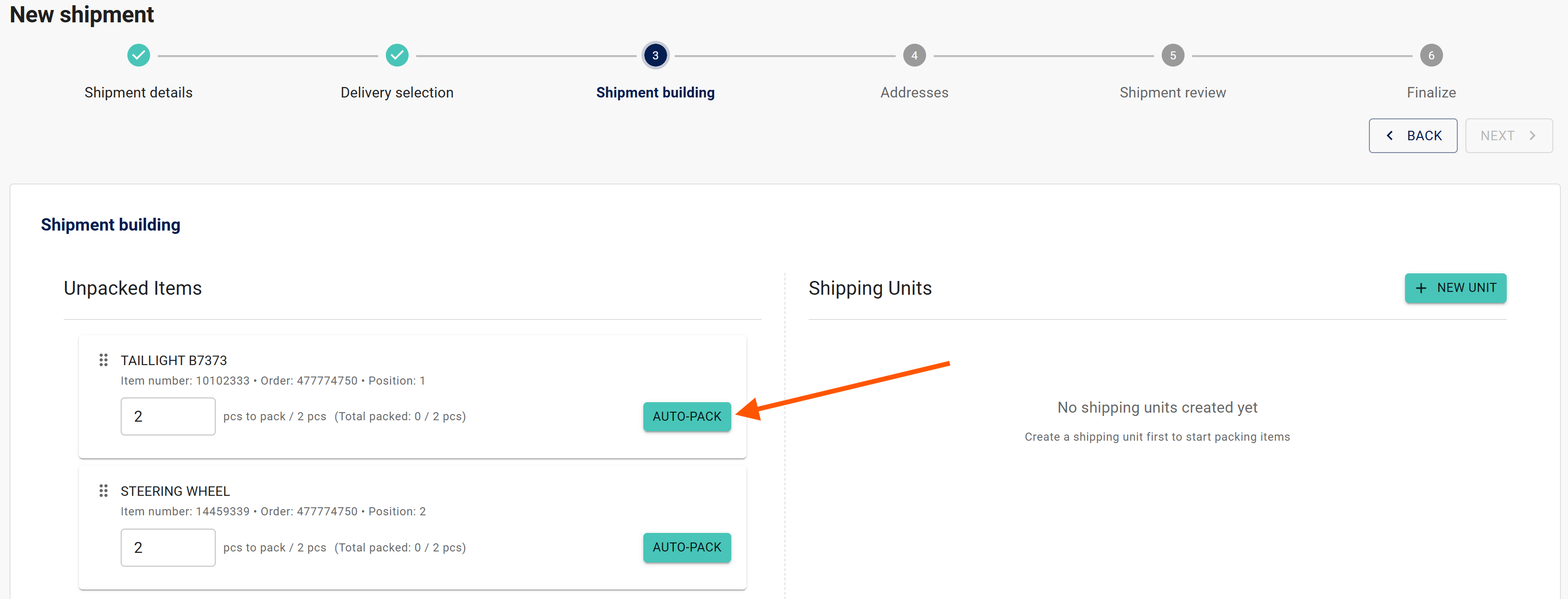
Auto-pack process follows these steps:
1. Choose structure: choose whether creating single-level structure or two-level structure (parent-child structure) of shipment units.
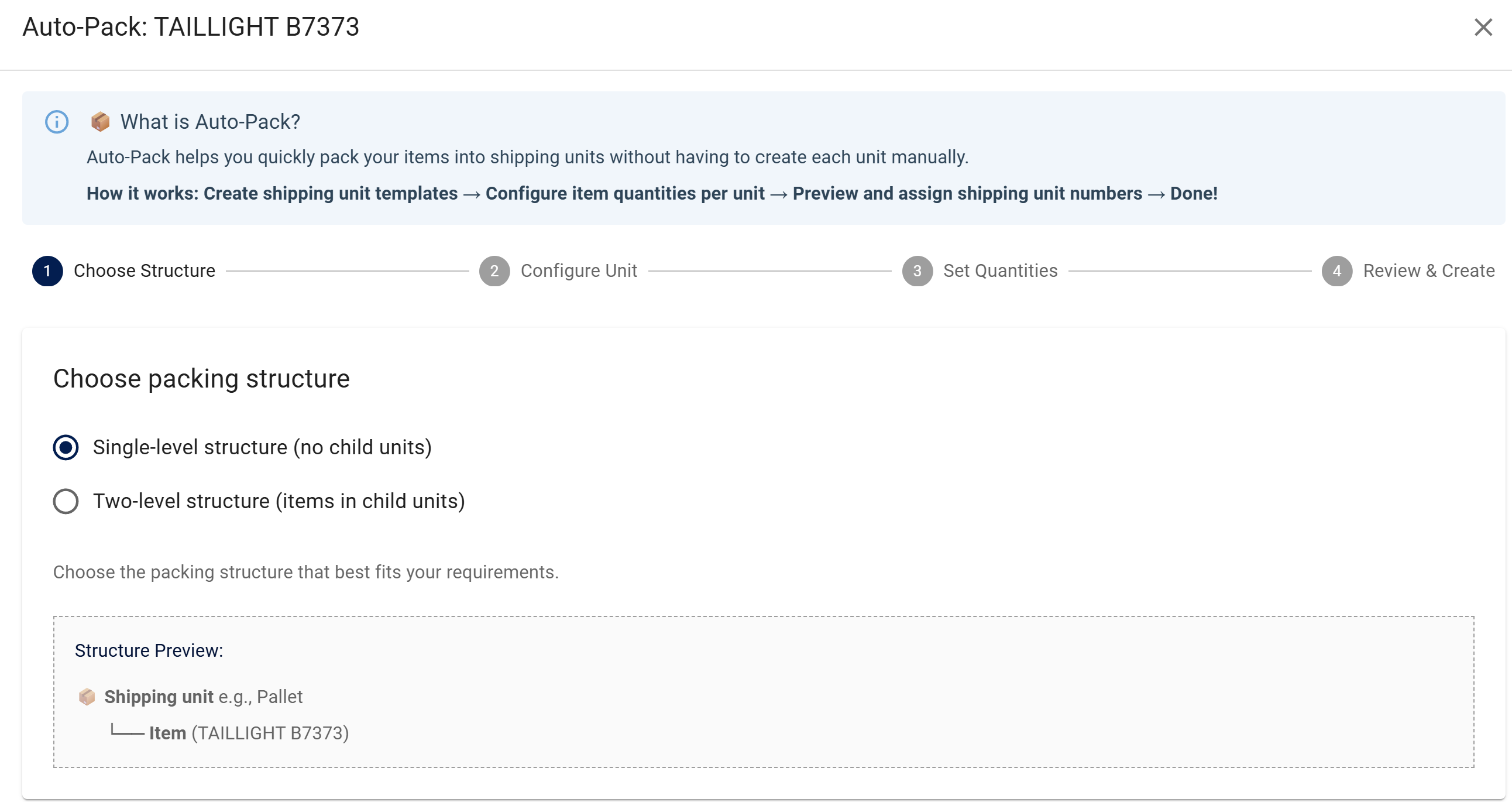
2. Configure unit: select which kind of shipping units will be created (one type).

3. Set quantities: select how many items will be added to one shipping unit.

4. Review and create: Jakamo will show how many shipping units will be created and how many items will be placed inside each unit. Fulfill unique Shipping unit numbers for each shipping unit before creating units.
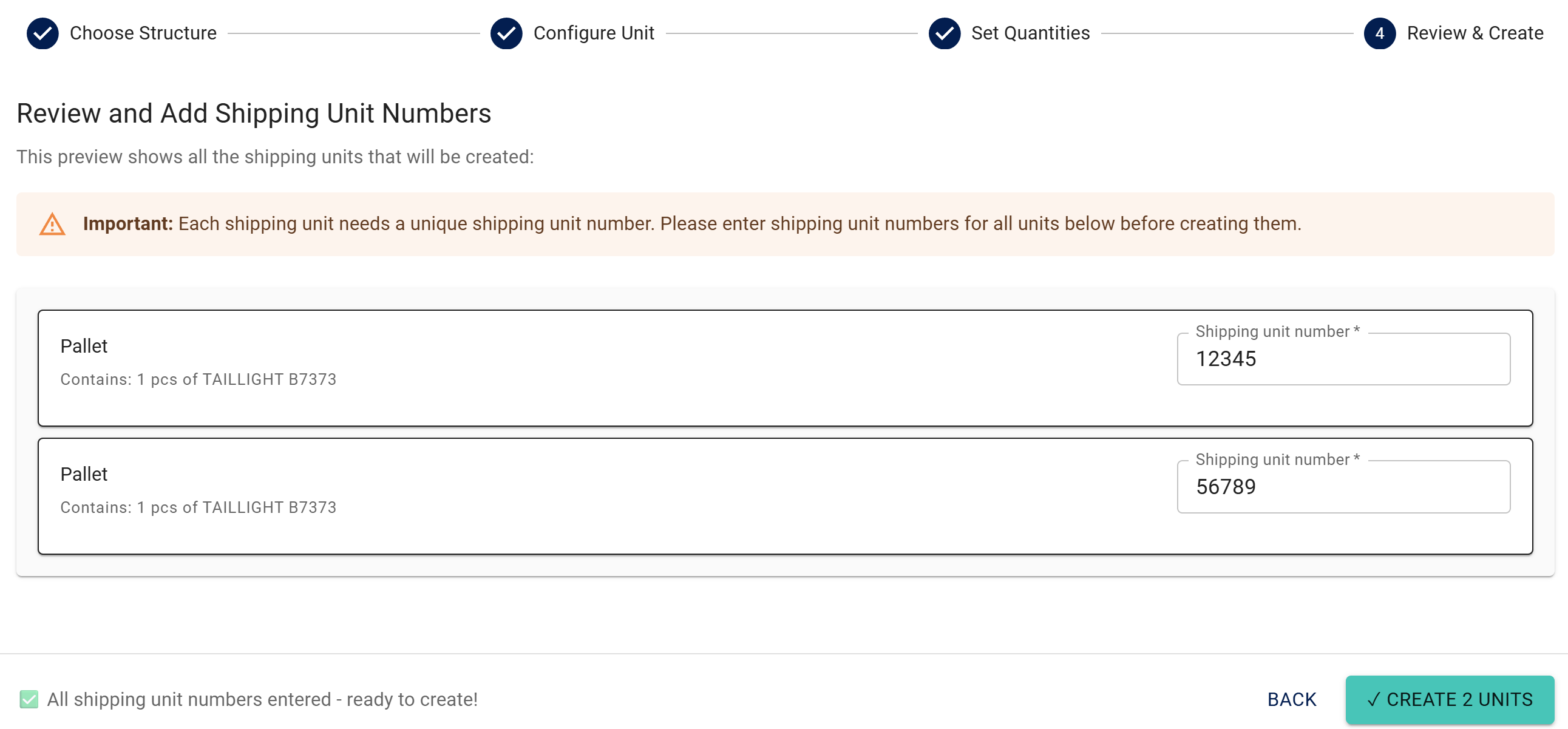
Select Create N units and you will now see those units in the Shipping Units section:

4.3.3 Serial numbers and batch information
For items tracked by serial number or manufacturing batch number, you can add the serial number or batch information after the item has been placed into a shipping unit.
Select SN or BATCH to add the information.
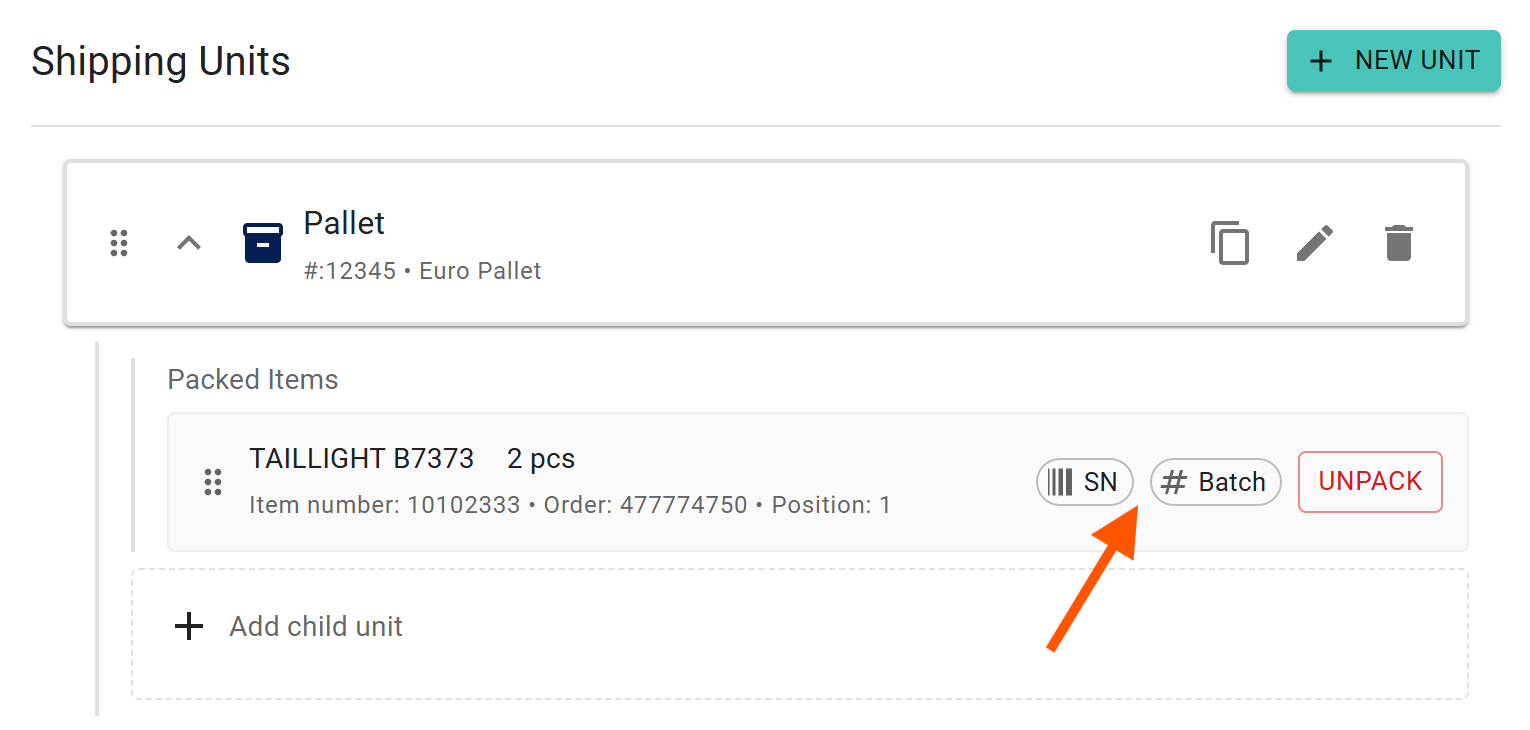
4.4 Addresses
Addresses page contains information about dispatch location and delivery location.
4.4.1 Dispatch information
Your customer may have restrict the dispatch information field, which means you, as the supplier, cannot fill it in. In this case, you can proceed with creating the ASN without entering dispatch information.
Dispatch location must always be the physical site from which goods are shipped to the customer. If your company operates across multiple dispatch locations, a separate entry must be created for each location.
Select the dispatch location from the dropdown menu from previously created locations, or create a new one by selecting Add +.
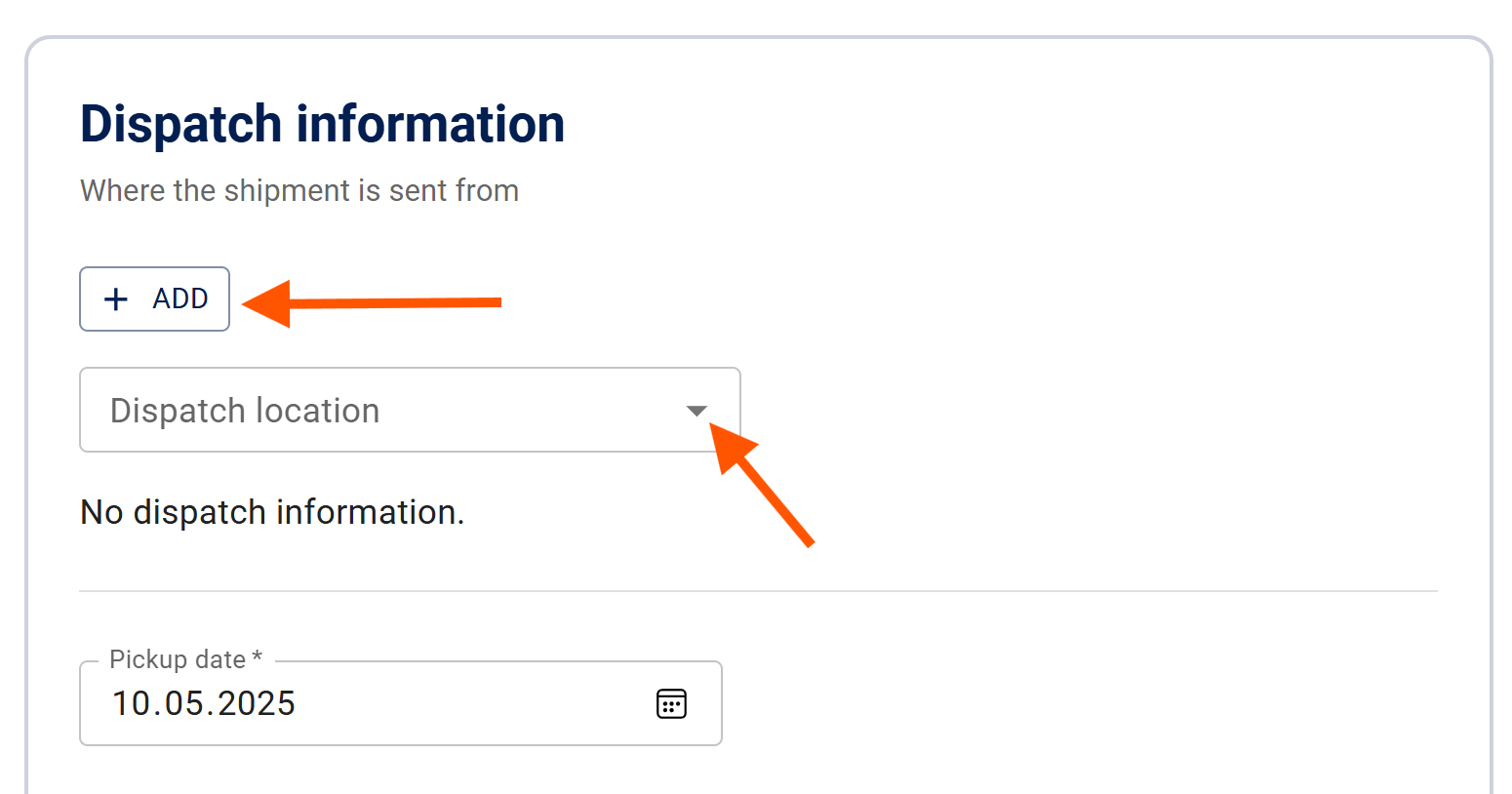
Create a new dispatch location
You can define dispatch locations, for example, for transportation purposes while creating new ASN. Saved dispatch locations are stored in Jakamo and will be available for all new ASNs. Select + ADD under Dispatch Information in order to add a new dispatch location.
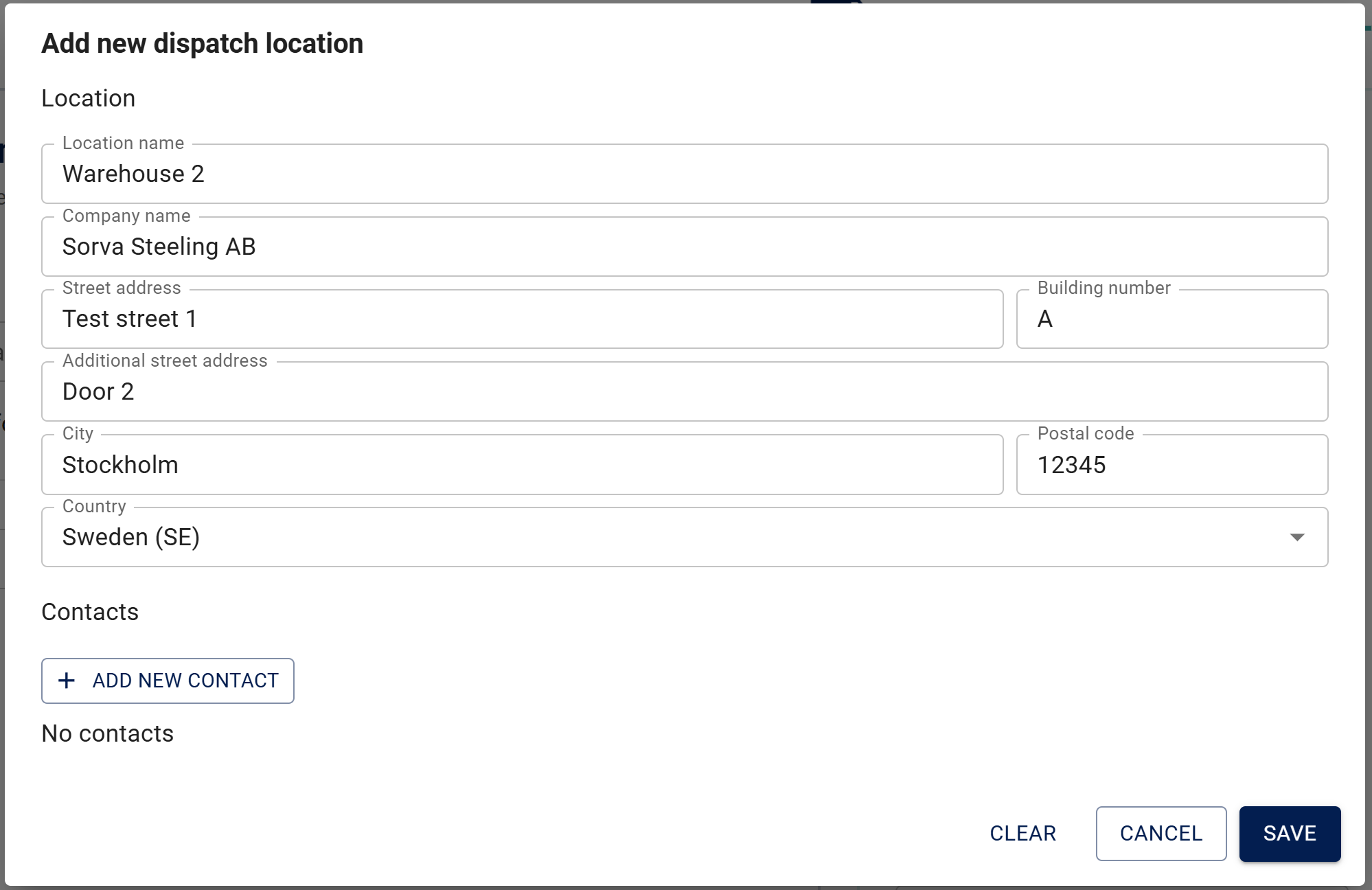
Use + Add new contact to add new dispatch contact person. Fulfill contact person's name, email and phone number and select Add to add person to be a contact person.

Select Save. You have now successfully saved your dispatch location and dispatch contact, and it can be now accessed from the Dispatch location dropdown menu.
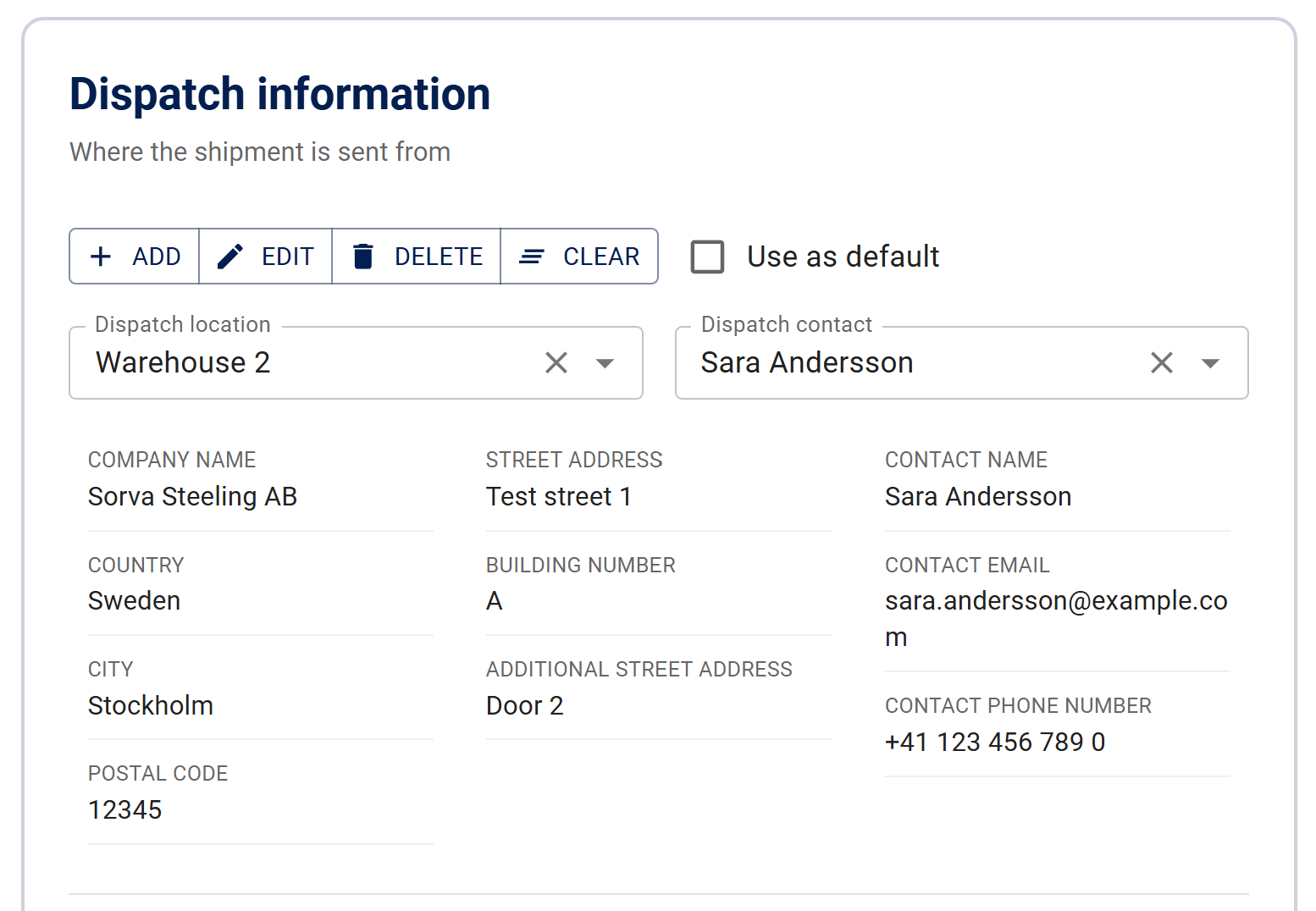
Pickup date
Pickup date is automatically the day order is planned to be delivered (confirmed delivery date). If needed, update the date to actual pickup date by selecting the correct day from the calendar.
4.4.2 Delivery information
Delivery location and address details, additional information including delivery method and delivery terms, and buyer contact person will be automatically pre-filled from the customer's order or orders selected to be shipped.
4.5 Shipment review
Review your shipment before finalizing it. Use BACK function if something needs to be corrected.
4.6 Finalize
On the Finalize page, decide what to do with the shipment you've created:
- Save as draft and continue later
- Print shipping label and packing list and attached those to the physical shipment
- Send ASN information to your customer via Jakamo
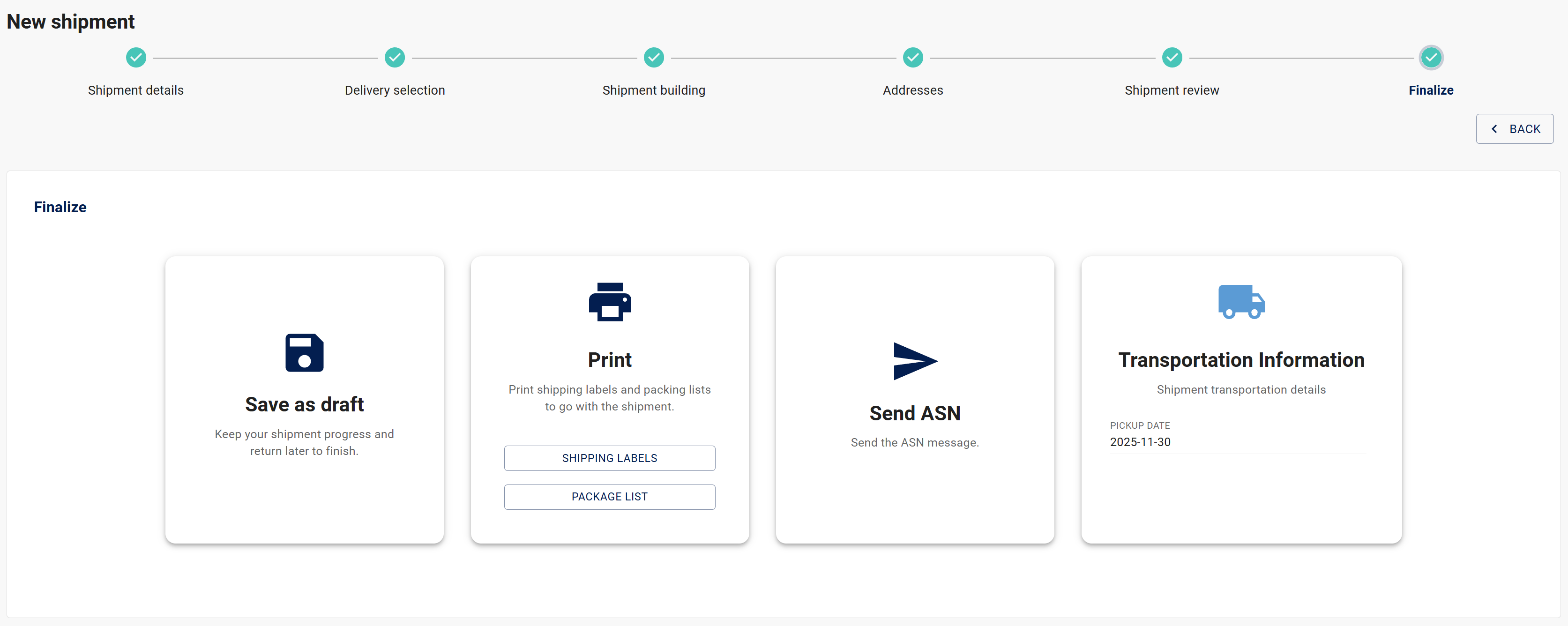
Send ASN
If the shipment is ready, you can mark the ASN as complete by selecting Send ASN. This action will take you to the summary view, where you can still choose to reprint the documents at the top of the page. If your customer requires an invoice to be created, you can do so after completing the ASN by selecting Create Invoice.

5. Settings
5.1 Templates
Templates can be used to standardize the shipment units and the their measurements. Templates are dedicated for customer company to pre-define shipping units, for example pallets or boxes with spesific sizes. Suppliers can then build shipments faster and easier by using these pre-made shipping units.
5.2 Locations
View your partner's dispatch locations they have saved in Jakamo.
5.3 Configurations
The customer company can customize which fields are required and visible for suppliers when creating ASNs in Jakamo.
Custommize required FIELDS which supplier needs to fulfill.
- Not used: not visible in the ASN creation process
- Optional: visible in the ASN creation process, but not mandatory to fulfill
- Required: mandatory to fulfill
Customize your ASN PROCESS by selecting which phases are included in your ASN creation workflow:
- Request transportation: Activate this function if you have an integration with a TMS or transportation booking system.
- Print labels: Enable this option if printed labels are required to be attached to the shipment by the supplier.
- Create invoice: Use this function if your invoice receiving process is integrated through Jakamo.
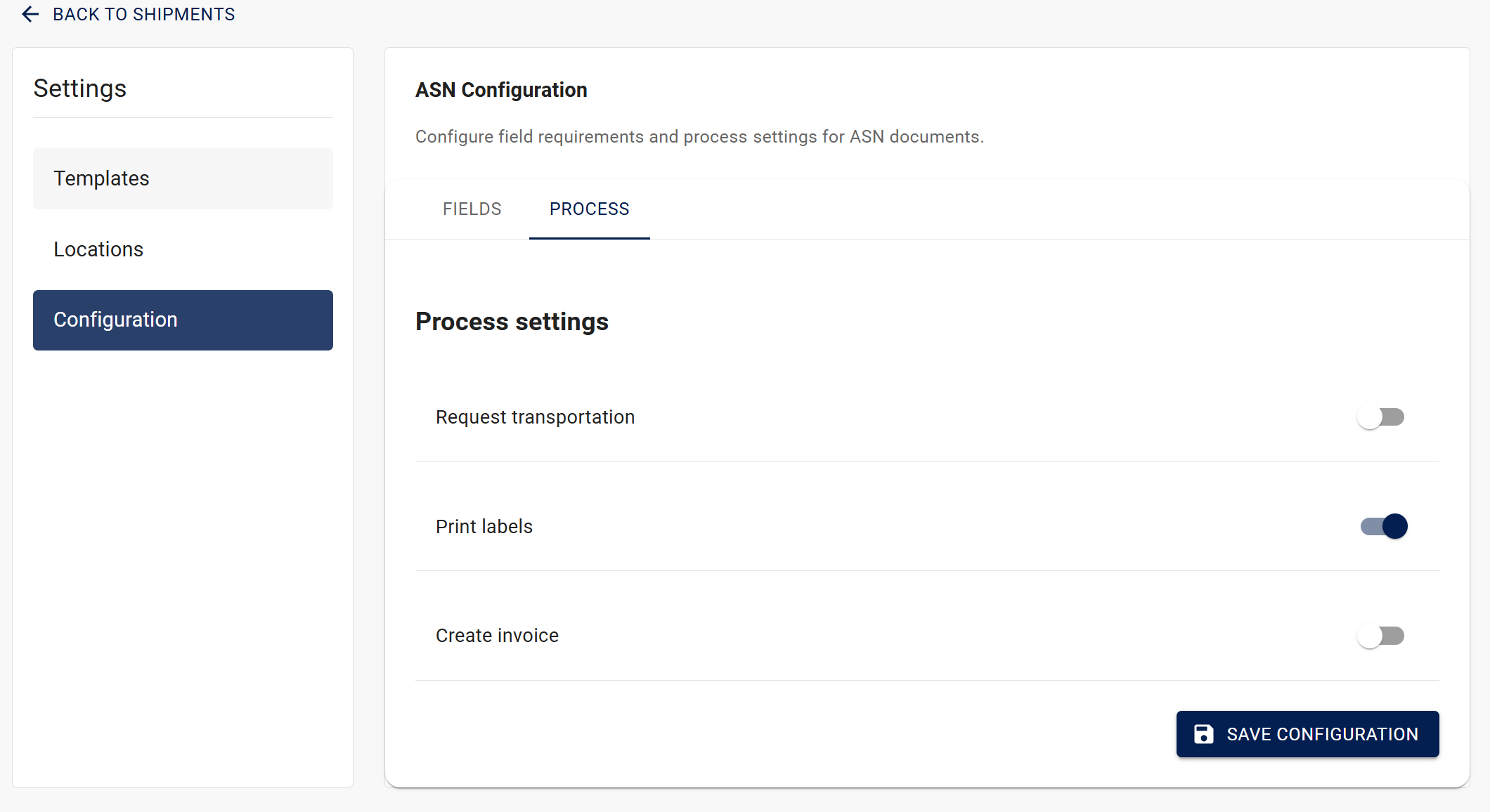
Didn't you find what you were looking for? Send an email to Jakamo support (support@thejakamo.com) and we will help you.
